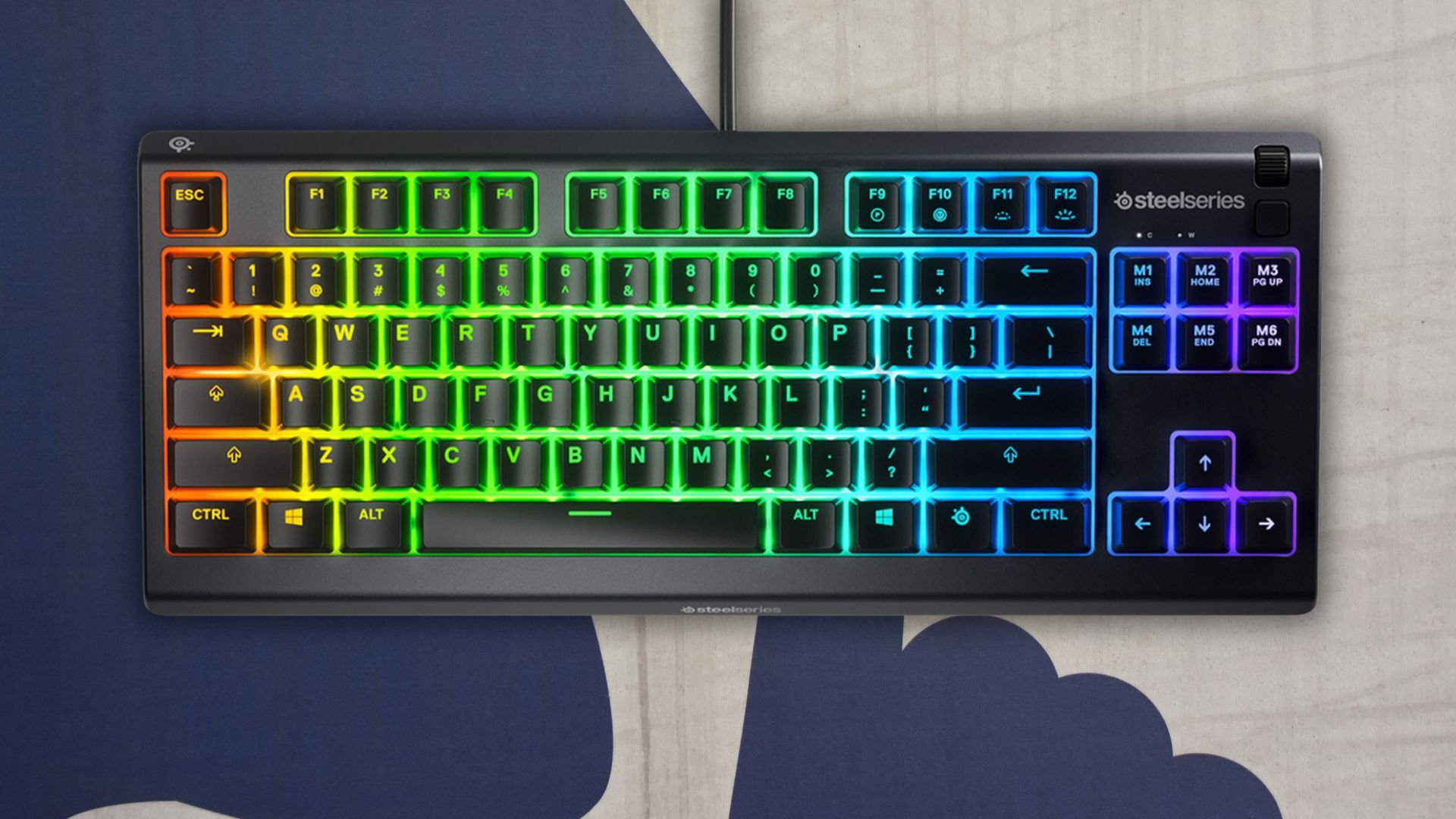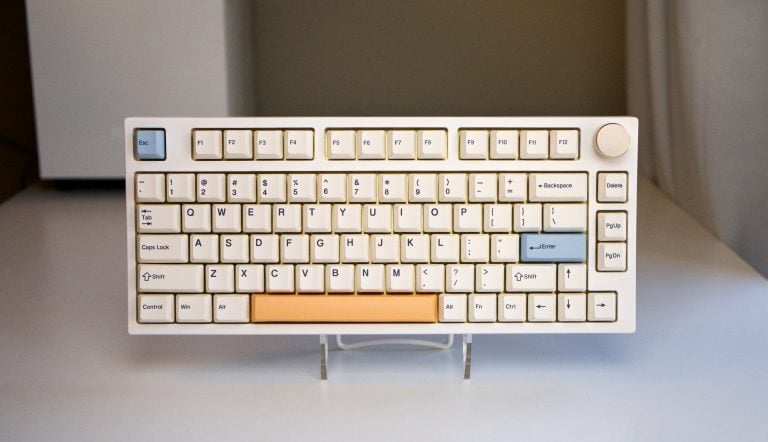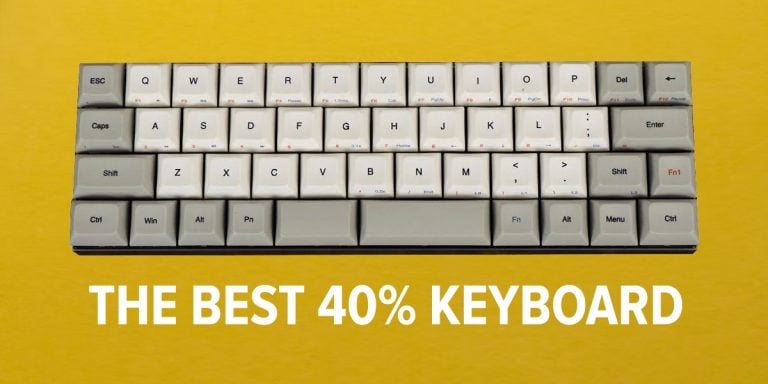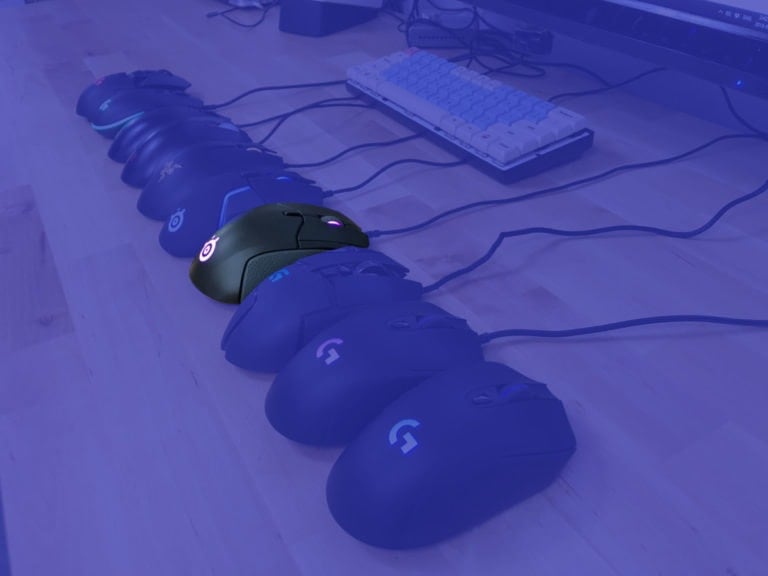A great quiet keyboard designed for gaming is hard to find. You want a keyboard that isn’t picked up by your microphone, but also perform well so you’re waking everyone in the house up cursing under your breath either.
I’ve personally reviewed dozens of keyboards. Here’s what I think are the best quiet gaming keyboards of 2023.
1. SteelSeries Apex 3 TKL

Pros
- Very quiet overall
- Affordable
- Volume rocker
Cons
- No wrist rest
- Keys are a little heavy
- Stabilizers are only okay
SteelSeries Apex 3 TKL is a great gaming keyboard priced at an affordable $50, and it’s also very quiet. This is not a mechanical keyboard, but it does use silent switches with a rubber-dome base for responsive keys. However, some critics have noticed the backspace and enter keys produce a louder sound.
The biggest selling point of the Apex 3 TKL is the water resistance which is pretty handy for long-gaming sessions if you have a small desk. It’s a keyboard built for casual and professional esport players with the typical gaming keyboard features, including a compact design, macro editing software, multimedia controls and RGB.
2. Keychron Q1
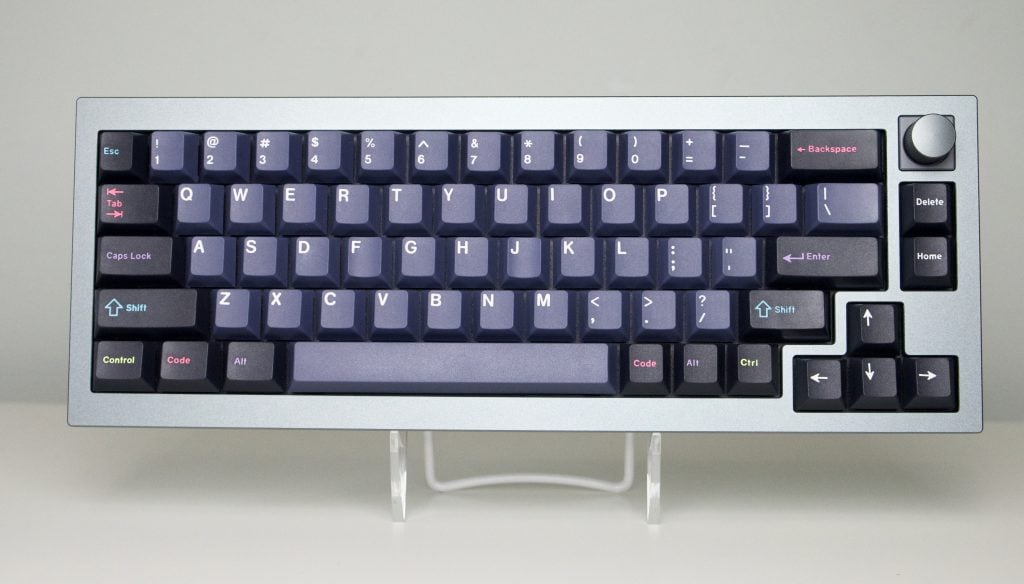
Pros
- Keys feel good at low profile
- Low profile switches are quiet
- Great RGB
- Fast wireless connection
Cons
- Micro USB port still
- Expensive
The Keychron Q1 is a mechanical keyboard with an aluminum body.
The main draw of the Q1 for quiet seekers is the foamed case and gasket mounted PCB. Along with picking quiet switches and having great stabilizers, the Q1 can produce a very serene gaming experience.
This is a great option for mechanical keyboard fans who enjoy spending time building their own keyboards. The hot-swappable sockets are PCB mounted, allowing the metal keyboard to work with every switch, keycap, stabilizer and plate to create a custom keyboard.
Prebuilds for the Keychron Q1 are available, which may come with silent and linear switches, which are ideal for a quiet gaming keyboard without needing to be any custom building yourself.
3. G915 TKL Linear
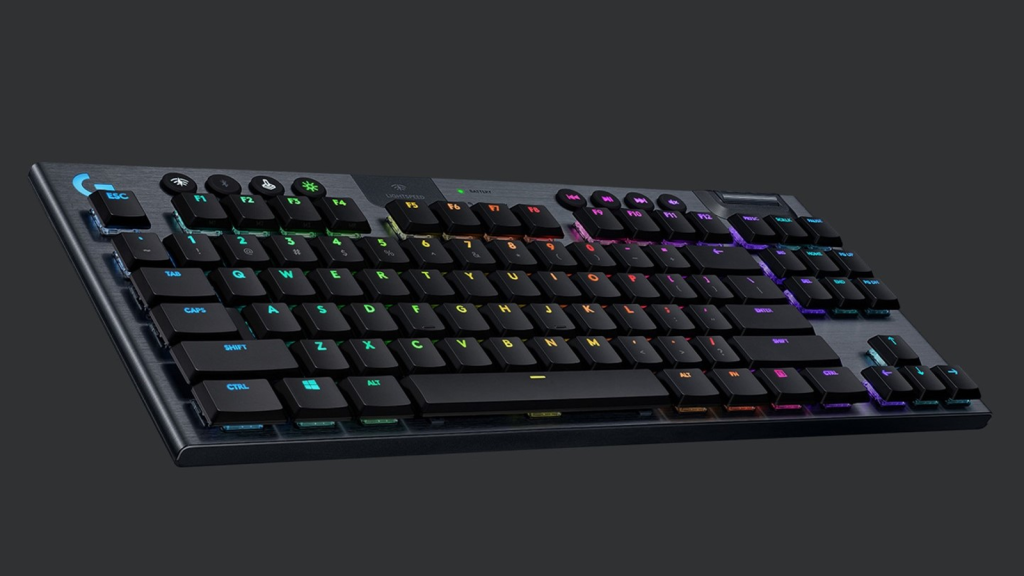
Pros
- Keys feel good at low profile
- Low profile switches are quiet
- Great RGB
- Fast wireless connection
Cons
- Micro USB port still
- Expensive
The G915 TKL is a mechanical keyboard with three switch options: linear low-profile, tactile quiet and clicky.
Opting for the linear or tactile switches will give you a quality mechanical gaming keyboard with reduced noise. The tactile and linear switches are quiet but, anyone who types forcefully and quickly will notice more sound.
Logitech’s G915 TKL keyboard with linear switches is the best option for reducing sound while typing and pressing buttons. However, button-mashing games may generate some noise from the keyboard while playing.
It’s worth noting that the G915 TKL is a near replica of the Logitech G915 Lightspeed. It keeps the same overall design but is smaller and slightly cheaper than the full-sized option.
4. FNATIC miniSTREAK Silent
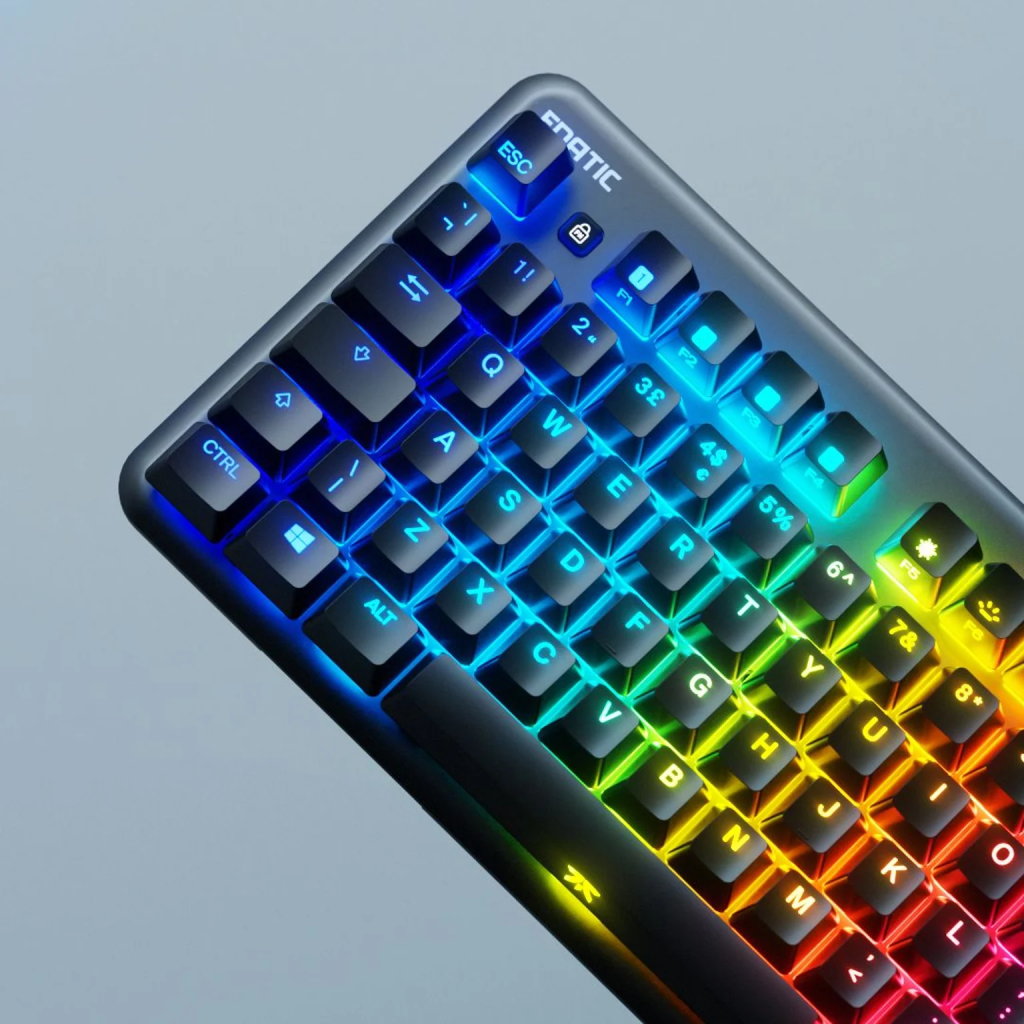
Pros
- Switches are fast
- Lots of customization in the software
- Silent red switches are indeed quiet
Cons
- ABS plastic keys
- RGB is mediocre
This is an updated model of the Fnatic Ministreak, which comes with two potential switch options: Cherry MX Silent Red and Kailh Speed Silver.
You want the model that features the Cherry MX Silent Red switches for extra quiet usage. These switches are top-tier for gaming, light and responsive for quick inputs, and offer low latency but best of all, they produce very little sound.
As a mechanical keyboard, the Fnatic Ministreak Silent is a good option for those who don’t need a huge number of extra features.
What makes noise in a keyboard?
The noise a keyboard creates depends on the components and their quality. Assuming there are no manufacturing errors or overall design issues, the components below are most likely the source of any loud keyboard noises.
Switches
The keyboard switches underneath the buttons are usually the main cause of loud noises. As you press the keys, each switch registers every single button press, which is then sent from the keyboard to the computer. While the button press will still make some sound, there are specially designed switches that make a reduced noise.
The quietest switches currently available are Silent Switches and Linear Switches. The Linear switches offer a better gaming experience overall, but it is possible to find Silent Linear switches for the best of both worlds.
O-Rings
Adding small O-Rings to your keyboard can also make your current mechanical keyboard much quieter. These rings are put on the stems of the keycaps and change the feel of key presses while also making each press quieter.
When a keycap presses all the way down, it hits the top of the switch enclosure, which produces a sound, but the keycap will make another noise when it springs back into its original position. Adding an O-ring shortens the travel distance for a full key press and cushions the keycap hitting the switch. This can absorb the vibration created by fast button presses for reduced sound.
Stabilizers
While not a component most people will ever see or think about, the stabilizers inside a keyboard prevent the larger keys from wobbling when pressed and help to bind the keycap to the switch. They sit around the switch to keep the keycap stable when it’s pressed.
Bad stabilizers can cause the keycap to wobble, tilt when typing and rattle to generate more noise. This can be fixed by getting a keyboard with well-lubed stabilizers to ensure smooth and balanced movement. It’s also possible to lube them yourself if needed.
Keycaps
Keycaps will always produce some sound because the keycaps touch the switch with every button press. There is no such thing as a silent keycap, but some keycaps will produce less sound.
Thicker keycaps typically produce a lower-frequency sound when it hits the switch, which is less irritating than the typically higher-pitch noise thinner keycaps produce. Denser keycaps will also produce less sound than hollow ones.
Thicker keycaps may be heavier and require more press force than hollow or thin keycap options.
Backplate/PCB
The material a keyboard backplate is made from seriously impacts its sound level when in use. Plates made from a dense material will produce a higher-pitch sound which is more irritating than the lower-frequency noise created by a lighter material. Aluminum is a common choice for keyboard manufacturers, but this is not the quietest option.
A keyboard with a plastic or non-metal backplate will reduce the noise it creates due to the more flexible materials, resulting in a lower-pitched sound and reduced bottom-out noise. A thicker plate will also allow a uniform bottom-out noise that removes the reverb typically seen in thinner backplates.
Gasket
Keyboards contain a gasket mount between the plate and the frame to give the keyboard a more cushioned feel since it won’t be in contact with the backplate. While this is type of keyboard mount is often more expensive, they reduce the noise of a keyboard.
Gasket mounts cause keystrokes to have less resistance as the keys will press into rubber instead of applying counter-resistance. It produces a more flexible feel and less noise when the keys bottom out against the switch underneath.
PCB
A common modification to reduce noise from the PCB is “tape modding”, which is a simple way to reduce noise from a mechanical keyboard. Adding layers of tape to the back of the PCB can reduce any hollow noises it would otherwise produce and change the overall sound profile. The tape prevents sound from travelling out of the PCB and mutes certain frequencies.
The best kind of tape to use is a paper tape with low adhesive strength, such as:
- Blue Painter’s Tape (the best option)
- Artist’s Tape (more expensive)
- Masking Tape (this adhesive is stronger, so be careful when removing it from the PCB)
If you don’t care about potential PCB damage, you could use anything, including plastic, cloth and metal tape.
Case
The keyboard case doesn’t usually produce sound by itself but can amplify the sounds created while using it. Getting a keyboard with a foamed case or adding foam to a mechanical keyboard will reduce the overall noise.
A foamed case is the best way to reduce the overall sounds, vibration and rattle produced while using the keyboard. While sound-dampening foam is a great option, it can be very expensive. A cheaper option is just to use the packing foam that the keyboard or another device was shipped in. Packing foam will not offer as good sound reduction, but it should still offer a significant improvement.
The process of adding foam depends on your keyboard case design and the type of foam you’re using. It’s best to find a keyboard-specific guide if possible. This is a pretty straightforward mod to do, but it’s still good to consult a case design manual for your keyboard first.
What I’m looking for in a quiet gaming keyboard
While membrane keyboards are much quieter than mechanical keyboards, there are features you can look for that make both options much quieter.
This means you don’t need to give up on the idea of getting a mechanical keyboard which is usually much louder than the standard membrane keyboards.
Of course, you must also consider what else you need in a keyboard, such as the size, media keys, numpad, and wired or wireless.
Here’s what makes for a quieter keyboard in my experience:
- Foamed case
- Quieter backplate
- Low profile keys
- Silent or Linear Switches
- Thicker keycaps for a lower-pitch noise
- Gasket mount
- Non-metal backplate
It is possible to mod the keyboard yourself and make it quieter overall, but starting with a keyboard designed to be quiet will make this much easier. Be warned, making your own modifications to a keyboard is likely to break any warranty it might have with the manufacturer.
Keyboard Switch Options
The key switches matter a lot since they’re responsible for a lot of the noise that comes from a keyboard. Linear and silent switch options are much quieter than the loud clicky switches usually found on mainstream keyboards.
- Silent switches have rubber dampening pads to absorb and reduce sound.
- Linear switches are designed for speed and less resistance which makes them quieter.
- Tactile switches offer the satisfaction of the tactile bump from clicky switches without being overly loud.
While tactile switches are much quieter than clicky switches, they aren’t the best option if you need the quietest keyboard possible. The worst option would be clicky switches which might feel great to use but are very loud.
Dome Switch
A dome switch keyboard is a hybrid between a mechanical switch keyboard and the classic membrane keyboard. These keyboards offer a good tactile feel to improve accuracy and have the potential to be much quieter than any silent mechanical keyboard.
These keyboards often feel like membrane keyboards and keep the same problems but are just as expensive as mechanical keyboards.

